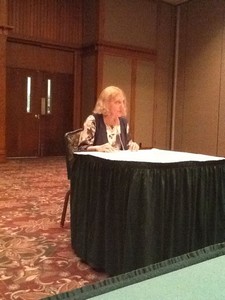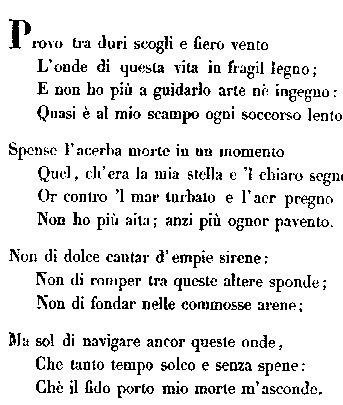
Ellen delivering a paper on Anne Radcliffe's nightmare landscapes
(during an 18th century conference) taken by Jim, 2/12
Ellen delivering a paper on Anne Radcliffe's nightmare landscapes
(during an 18th century conference) taken by Jim, 2/12
|
To the reader: you have come upon Ellen Moody's website as constructed by her husband, Jim Moody. Her website is a literary and academic one. It is divided into areas referenced under the names of individual authors: Winston Graham (1908-2003) and Anthony Trollope (1815-1882); Jane Austen (1775-1817); Sophie Cottin, nee Risteau (1770-1807); Frances (Fanny) Burney d'Arblay (1752-1840); Isabelle de Crousaz, baronne de Montolieu (1751-1832); George Anne Bellamy (c. 1731-1788); Samuel Richardson (1689-1761); Anne Kingsmill Finch, Countess of Winchilsea (1661-1720); Anne Murray, Lady Halkett (1623-1699); Vittoria Colonna (1492-1547); and Veronica Gambara (1485-1550). There are also sections referenced as e-text editions, women's poetry and translations, gothics and historical fiction; reviews and conference papers, and film studies. |
|
For Anthony Trollope and in conjunction with her book, Trollope on the Net (published by Hambledon Press and the Trollope Society), Ellen has placed upon this website a chronology of Trollope's writing life. She has reproduced a large selection of and commentary on the original and more recent illustrations of Trollope's novels. She is now placing on the site some of Trollope's hitherto unpublished or hard-to-find criticism and non-fiction, including his obituary for G. H. Lewes. All these materials are accompanied by extensive bibliographies. She has placed on this site her lecture to the Trollope Society "Trollope's Storytelling Art: Partly Told In Letters" (published in Trollopiana and "The Victorian Web) On Trollope she has also placed here essays and threads from conversations on four of his Anglo-Irish and his six Barsetshire novels, including The Small House at Allington, and The Last Chronicle of Barset; on his historical novel, La Vendée; on two mid-career, Rachel Ray, The Belton Estate, three "heroine's texts" (Miss Mackenzie, Nina Balatka and Linda Tressel), and four later novels, Is He Popenjoy?, The American Senator, John Caldigate, and Ayala's Angel; as well as on the BBC film adaptation of The Way We Live Now, The Palliser Films, Trollope's short stories, and his travel book, North America. There are postings by members of Trollope19thCStudies (previous name: Trollope-l) on where they write from. She also includes 2 conference papers: one for a Trollope Exeter Conference: Trollope's Comfort Romances for Men: Heterosexual Male Heroism in his Work (see also The Victorian Web); the other at a Sharp (Book History) Conference: Mapping Trollope; or Geographies of Power (on The Victorian Web). For Winston Graham's historical fiction, focusing on his Cornish and 18th century series, the Poldark novels, she has brought together on one page all her essay-blogs on his books and their film adaptations. There is also a select working bibliography of Graham books and historical fiction.
|
|
|
On Women's Poetry The Canon: The three women she has done most work on: Veronica Gambara, Vittoria Colonna, and Anne Finch. In this section you will find one of the earliest sonnet sequences attributed to a woman poet, Anne Cecil de Vere (first published in 1989 in English Literary Renaissance); her essay on the poetry of Katherine Philips known as "Orinda" and a reprint of Philips's translation of "La Solitude" by Antoine Girard Saint-Amant (1594-1661). For Anne Finch, Countess of Winchilsea, Ellen has placed here a literary biography, I On Myself Can Live, with a bibliography of all primary and secondary sources. She has also placed on her website a narrative life of Anne and Heneage Finch (4th Earl of Winchilsea), Apollo's Muse commissoned by an English Baroque ensemble, Musica Dolce. She gathered, arranged and placed here nearly 50 texts by Finch which have either never been printed, are printed in censored versions, have not been attributed to her, or occur in rare books. She provides a list and bibliography of all the sources for Finch's fables, adaptations, imitations, and translations, and she reprints the hard-to-find and scarce source texts. She describes the manuscripts and printed books in which these poems are found and has created a cross-indexed annotated chronology for all Finch's poems. All these texts and the annotated chronology, combined with the texts printed by Reynolds and a recent edition of the Wellesley manuscript, provide the student with essential texts and tools for a study of Anne Finch's poetry. She has also placed on the site her unpublished essays Anne Finch and Mary Wortley Montagu, Sister Poets, "'I hate such parts as we have plaid today'" (delivered as a conference paper), and Anne Finch as a translator, with an updated bibliography of translation studies. |

|
Two early modern women great Italian poets. Vittoria Colonna's Amaro Lagrimar, a translation; a prospectus towards a biography: portrait lives of Colonna and Colonna's husband,
Ferrante
Francesco d'Avalos; a chronological summary, A Dark Voyage; and chapter, "Pawn and Wife"; a bibliography
She has also placed here Secret Sacred Woods, her translation of Veronica Gambara's poems (with an illustration from an 18th century edition); biography, Under the sign of Dido; notes on misattributions, and a bibliography. As background to both translations and Italian women of the era: an essay on translation; and review of Gabriella Zarri's Per lettera: Le scrittura epistolare femminile tra archivio e tipografia secoli XV - XVII |
|
Women's Novels: for Jane Austen and in conjunction with an essay Ellen wrote (published by Philological Quarterly) "A Calendar for Sense and Sensibility", Ellen studied all Austen's novels minutely and drew extensive detailed calendars from them that are in these books and provide the undergirding of of all Austen's serious realistic fiction. The calendars are accompanied by a chronology of Austen's writing life. She has placed here her published "Jane Austen in French", and essay-review, Jane Austen on Film: Or, How to Make a Hit, together with a bibliography of studies of film adaptations of Jane Austen's novels, a conference paper, "Jane Austen Among Frenchwomen", and from Jane Austen and Bath, "In Search of 18th Century Bath: A Visit" and "The Present Impossibility of Biography". And she includes on her website essays she sent to Austen-l and Janeites in the form of postings on Austen's Sense and Sensibility and Mansfield Park, and Northanger Abbey; and blogs in the forms of essays on Austen and Austen-related matters. |
|
Ellen wrote her dissertation two epistolary novels centrally influential on the modern psychological woman's novel: Samuel Richardson's Clarissa and Sir Charles Grandison, and epistolary narrative. In 1995 she led an online mostly academic conversation which emerged from reading Richardson's Clarissa in real time She has added to that since and so made a website for all the materials she hoped others might find useful, e.g., a film study of the 1991 BBC/WBGH mini-series Clarissa: "'How you all must have laughed. Such a witty masquerade'", from her study comparing the novel and film and a paper "'What right have you to detain me here': Rape in Clarissa. Her website includes a detailed comparison of the novel and film, a select bibliography of studies of Richardson and film studies, and link to her website on epistolarity in the novels of Jane Austen, Anthony Trollope and real women's letters from the Renaissance.
|
|
She has spent much time working on 18th century women writers, French and English. Frances (Burney) D'Arblay was directly influential on Austen and her diary an important step in the development of women's life-writing. The reader will find here about Burney three published essays, "Fanny Is Us", "On First Encountering Fanny Burney d'Arblay", and "On Reading Divergent Fanny Burney d'Arblays", reviews of books on Burney, Laclos and Riccoboni and Burney's female English romantic contemporaries -- as well as a bibliography and cyberspace postings which occurred during a group conversation on Fanny Burney's Evelina, Cecilia, Camilla, The Wanderer. She has sections devoted to later 18th century French women writers who also influenced Austen and wrote effective novels widely read in the era and relevant to us today: Isabelle de Montolieu's partly epistolary novel, Caroline de Lichtfield, her travel book Les Chateaux Suisses, is accompanied by the only biography in English a portrait, and a bibliography. Sophie Cottin's iconoclastic epistolary Amelie Mansfield, is also accompanied by a bibliography and links. Mary Trouille's study of wife abuse in 18th century France from contemporary memoirs, court records, and novels completes this section. She has a partially complete section devoted to 17th and 18th century English women autobiographers. Those who wrote of their experience of the English civil war The Autobiography of Anne Murray, Lady Halkett and The Letters of Lady Brilliana Harley. She has put the first and second volume of the still rare 6 volume autobiography of George Anne Bellamy. Chatto & Windus's edition is a two volume abridgement(hostilely edited). Crossing eras, she has a section devoted to the female gothic and l'ecriture-femme. This includes Ann Radcliffe's The Romance of the Forest; Elizabeth Gaskell's Cranford, Cousin Phillis; Suzy McKee Charnas's The Vampire Tapestry; and Ruth Prawer Jhabvala's East Into Upper East. |
John Atkinson Grimshaw (1836-93), A lady in a garden by moonlight" (1882)
Ellen has also brought together her published reviews in "Reviewer's Corner", covering a variety of topics from the Renaissance through 19th century, including studies of places, e.g., Peter Borsay's The Image of Georgian Bath. There is a section for "Conference Papers" which includes a study of Women in Cyberspace; reports on conferences. |
|
She concludes with a miscellany of conversational postings: conversations posted to the Net. The subjects range from biography and travel books, e.g., Boswell's Life of Johnson, together with Boswell and Johnson's paired books on their tour through the Hebrides), John Sutherland's Life of Walter Scott, to discussions of children's literature and girls' books. Her site also includes the syllabi and various other teaching materials for those courses she is currently teaching or has taught at George Mason University. Here she includes bibliographies which her students have found useful for research, e.g., on children's literature, on the medical subculture of our society, on on archaeology, human genetic heritage and migration and language history, and on Richard Feynman). |